Some of the links on this page are affiliate links. When you make a purchase through an affiliate link, I earn a commission at no cost to you. See my entire disclosure policy for all the boring details.
In this post, you will learn 5 ideas for how to deal with the terrible twos that actually work! We’ve gone through the two year old stage with all 4 of our kiddos, and I’ve interacted with tons of other toddlers as well.
Update: As of 2024, we have a 5th two year old! We adopted a little guy who’d been in and out of our home for about 18 months. He came to live with us full time right before he turned 2. Because he’d been born very prematurely, he was developmentally around 16-18 months when he came. I’m updating this post since we’re back in toddler stage again! I stand by all of it. 2 can be an AMAZING age if you have the right mentality and some practical parenting tips that will help you patiently train your toddlers.
After going around the block a couple times, age 2 has become one of my favorite stages. If you can get a few tools in your parenting tool belt & approach two year old behavior confidently, you’ll be more likely to enjoy your child at ages 2 and 3! These years do not have to be terrible 🙂
The 5 strategies you will learn in this post are:
- 1. Right thinking about a 2 year old’s development
- 2. Finding your firm, clear, parent voice
- 3. THREE key phrases to say to your toddler
- 4. The power of not making a big deal
- 5. Time out
At the end, there will also be some FAQs including questions about how screens affect toddler behavior & about strong-willed children.
Let’s dive in!
1. How to Think About the Terrible Twos Terrific Twos!
Don’t skip this part!! It might not sound like a “practical” tip, but the way you think about your 2 year old and the way you see your role during the toddler years is crucial to making the more hands-on strategies work!
Know Your Child’s Nature
Our 4th child is officially a full blown 2 and a 1/2 year old. A limit-testing, boundary-pushing, bedtime-delaying toddler. Interesting how much a toddler’s behavior tells you about human nature.
- The desire to be in control, in charge.
- The desire to be right.
- The desire to get what you want. RIGHT NOW.
- The desire to be the sole focus of everyone’s attention.

I mean, really, don’t we see all that toddler behavior in ourselves as adults too?
It’s funny… I didn’t have to teach my toddler to yell “No!” or grab something out of her sister’s hands. I didn’t have to teach my toddler to say “that’s mine” in a snobby voice or how to throw herself on the floor and scream when she doesn’t get something she wants.
She just knew how to do all that. It’s not “learned.” It’s in a toddler’s nature.
A lot of the problems parents experience with their toddlers have to do with a misunderstanding about their child’s nature! It’s surprising to see your sweet googly-eyed, smiley, drool-faced baby turn into a tiny destructive monster of sorts… and the current culture seems to subtly convey to parents that this is your fault. That somehow if you could be the perfect combination of lovingly gentle & strict & firm & consistent, your 2 year old would not act like that.
But the fact of the matter is – toddlers have been testing boundaries and throwing tantrums since the beginning of time. They’re not being “terrible,” they’re just being two! I actually have a pretty strong preference NOT to call my two year olds terrible. The Danish call it “the boundary stage.” I like that much better.
Anyway, John Rosemond goes into much more detail about the development of toddlers in his book, Making the Terrible Twos Terrific! I highly recommend it to ALL parents!! It’s the BEST book out there about parenting toddlers. (Grab his potty training book while you’re at it too!!)

The first step to effective toddler discipline is to take a deep breath and realize – the 2 year old behaviors you’re seeing are 100% normal. 100% of parents go through this.
Take a deep breath. You don’t have to to stress over your child’s every meltdown for the next 12-18 months. You can confidently approach 2 year old discipline and come out on the other side of the “terrific twos” with a happy, well-adjusted child.
Be Prepared: This Undesirable Toddler Behavior Usually Starts Around Age 1!
Can you believe it? Your sweet little angel, who just learned to toddle around, is all of the sudden screaming & throwing themselves on the floor? Where in the world did they learn this behavior!? Good news! It’s not you, it’s them.
This is how toddlers are wired. (Here is a very thorough guide to 1 year old discipline & behavior if your child is developmentally closer to 10-19 months.) The methods in this guide are positive, proactive, simple, and EFFECTIVE.
Know Your Job in the 2 Year Old Discipline Process
My post, A Practical Guide to the Parent Led Home explains the idea of a parent-led home in more detail. But, the main idea is – it’s our job (as parents) to raise the children.
We make decisions about what’s best for them based on observing them and getting to know each of our children. And we pray a lot. (That post goes into more detail about practical tips and specific scenarios!)
Of course, we don’t always get it all right; sometimes, we make the wrong decision! Thank goodness for grace! But in general, I have the responsibility of teaching my toddler or preschooler how to…
- respect authority
- wait patiently
- take turns
- be kind
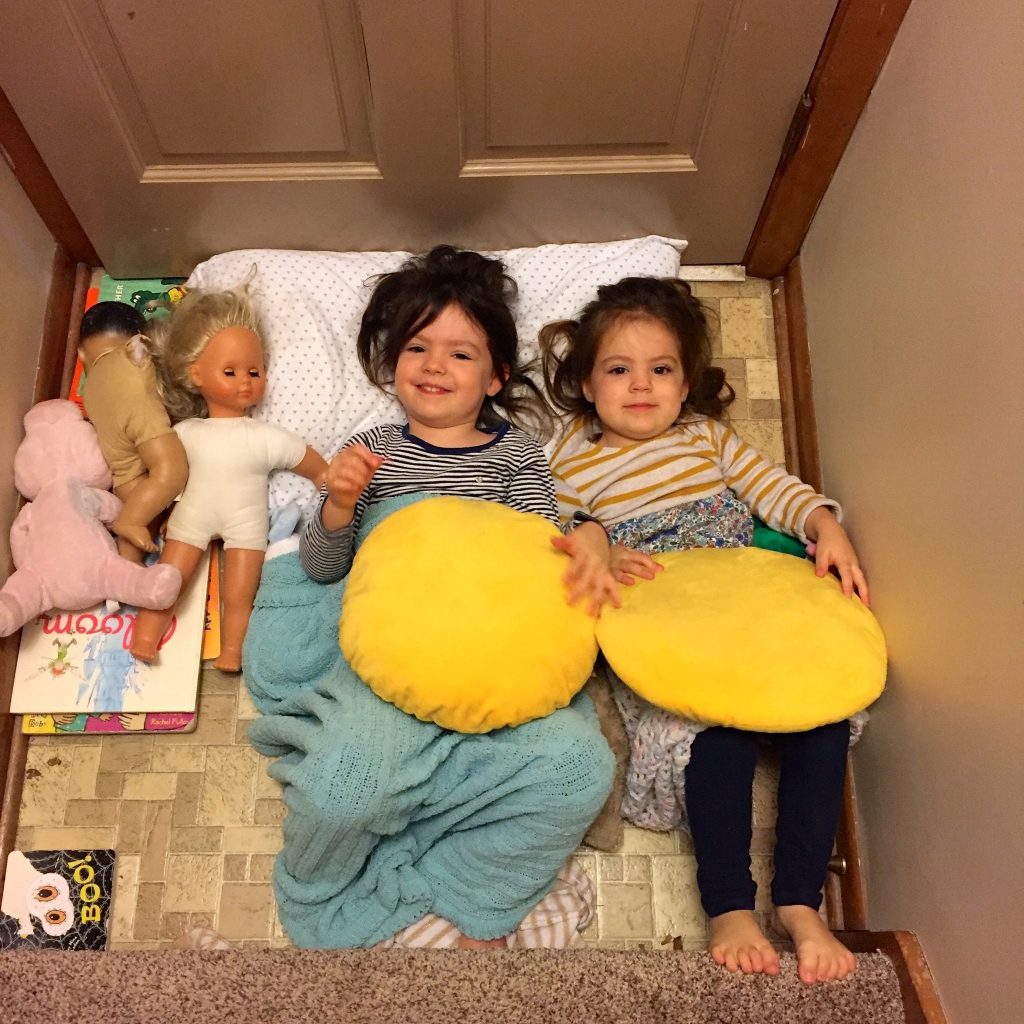
But How?
How to discipline a toddler is the tricky part… Because as you have likely experienced first hand, most toddlers do not just comply every time you tell them, “don’t do that.”
Haha! Wouldn’t that be great?!
Full disclosure: I’ve caught myself saying “because I said so” and “just because” and “I don’t know, just do it” and all those things my mom said that I swore I’d never say.
And, it’s okay. Sometimes that’s just the answer.
But this question of how to discipline brings us to strategy number two…
2. Find Your Firm, Clear Teacher Voice
Your best teacher from elementary school probably had this voice down pat! It’s the firm and clear voice where you knew the teacher meant business but she wasn’t harsh or mean.
Your Grandma might have had this voice down pat back in her day too!
You’ll want to avoid the modern parenting trap of trying to coerce your 2 year old into “cooperating.”
Here is an amazing explanation of this type of voice from John Rosemond (he calls it “alpha speech” or “leadership speech”):
The concept of alpha speech is not original to me. In generations past, it was widely understood to be the essence of proper child discipline. I simply named it. … Regardless, it is the very traditional understanding that the successful discipline of a child is more a matter of properly conveying authority than properly using consequences (albeit the latter is also important).
As a rule, today’s parents believe in behavior modification. They believe in techniques, such as time out and star charts and approaches of that sort, approaches that involve the manipulation of reward and punishment. Somewhat derisively, I refer to them as “consequence delivery systems.” …
In fact, researchers have found that reward and punishment, when used with children, can be and often are counterproductive, which goes a long way toward explaining why the behavior and discipline of children has become increasingly problematic since parents began relying on behavior modification…
Alpha speech in four parts: (1) When giving instruction to a child, speak from a fully upright position (as opposed to the silliness of “getting down to the child’s level.” (2) Use the fewest words possible. (3) Do not explain yourself, but simply tell the child what you want him to do in a matter-of-fact tone. (4) When a child wants to know “Why?” (which is what children ask in the absence of an explanation), your answer should be “Because I said so” or a variation thereof.
For example, if you want a child to put on his coat and wait by the front door, you say, “I want you to put on your coat and wait for me by the front door.” You DON’T say, “I have to go down the street and give a casserole to Miss Gloria and it would really help Mommy if you’d put on your coat because it’s chilly out and wait for me by the front door.” That approach is likely to draw resistance of one sort or another. (emphasis mine)
Alpha speech is nothing more than saying what you mean and meaning what you say… It is neither threatening or promising. Oh, and when the child obeys, it is best to say simply “Thank you” without an exclamation point as opposed to “Good boy! Mommy’s going to take her little man to the ice cream store later today!”
– John Rosemond, article on Arcamax.com
Before you start speaking to your child, see if you’re using a coddling/ cooperating type voice or an alpha-speech type voice!
Train yourself to speak firmly, clearly, and simply as much as possible. It’ll make a difference!
Once you figure out this tone, using the 3 phrases explained below for 2 year old behavior & discipline will be immensely helpful.
I’ve said all 3 phrases ad nauseam for the last 6 years of having a toddler in our home. (And I’m back to saying them again since we have another one.)
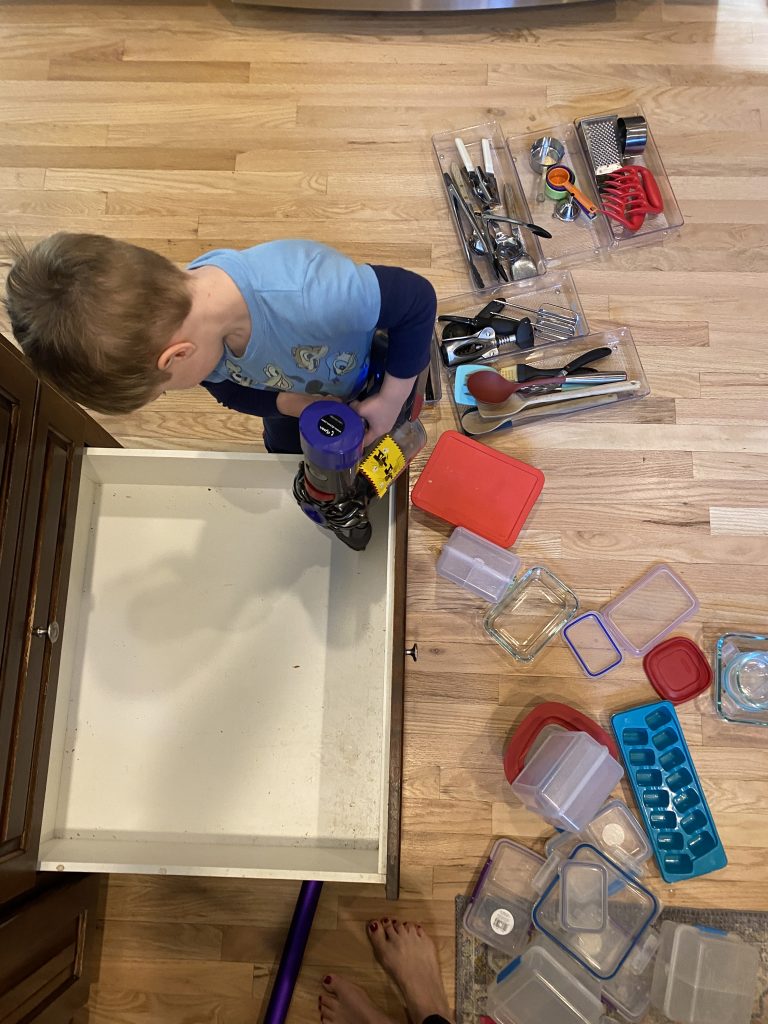
3. Three Key Phrases for Toddler Discipline
We’ve used several specific phrases with our 2 year olds that have really helped them learn and practice obedience, kindness, patience, etc... We actually learned most of them from my parents! Allegedly, my dad used to say these to my brother and I when we were toddlers.
When our first child was 2, my dad (promoted to Granddad) used all 3 of these phrases on a family trip with our 2 year old. And they “worked!”
Turns out – you don’t need a fancy toddler behavior chart… you just need to know how toddlers think and how to communicate clearly and lovingly to them.
But, we’ve used several specific phrases with our 2 year olds that have really helped them learn and practice obedience, kindness, patience, etc…
Terrific Two’s Phrase #1: You Are Not in Charge.
Update: I originally wrote this post when we had 1 two year old. I’ve edited it since bringing 4 kids through the terrific twos and this stands as the NUMBER ONE MOST USEFUL THING IN OUR HOME WITH A TODDLER. If you want to correct terrible toddler behavior, get used to saying this in your firm mommy teacher alpha speech voice.
I love my toddler and I love her spunk, her go-getter spirit. But it’s good that she knows she’s not in charge. Not only is it good. It frees her up to be a kid! Kids push push push and test test test, but deep down they want to know where you draw the line.
That’s why the Danish call it “the boundary phase.” Your two year old isn’t terrible… she is wired to test the boundary!
Some kids will push and test more relative to other kids, but how much they push is not really the issue for this phrase.
It’s just a simple reminder, stated calmly and frequently. You are not in charge.
Scenario:
Mom: Time to get ready for bed. Please go get your jammies.
2 year old: I don’t want to go to bed.
Mom: I understand, but you’re not in charge. Go get your jammies.
At this point, anything defiant is disobedience and should be dealt with however you deal with explicit disobedience in your home. (Time out, loss of privilege, etc.)
If you want more concrete advice on discipline, I’d highly recommend Parenting By the Book for a refreshingly positive and practical look at Biblical parenting & discipline.

Phrase #2: You Don’t Get Everything You Want (And Neither Do I)!
This is a great rebuttal in place of “it’s not fair…” I like this a lot better than “life isn’t fair.” It’s more positive and more toddler appropriate. Most 2 or 3 year olds aren’t talking about ‘fair’ unless they’ve heard an older sibling discussing the subject anyway 🙂
Scenario…
Dad: It’s your sisters turn with that toy.
2 year old: No I want to play with it.
Dad: Well, you don’t get everything you want.
2 year old: Why?
Dad: because that’s a part of life. No one gets everything they want. I don’t get everything I want either. (Depending on your 2 year old’s comprehension and verbal ability, you could even give an example of a recent time you didn’t get something you wanted.)
Toddlers will make the connection – Mommy doesn’t get everything she wants. Sister doesn’t get everything she wants. Daddy doesn’t get everything he wants. It’s a part of life, something better learned sooner than later.
Granted, your toddler will still need frequent reminders. 🙂 Let’s be honest; I need a reminder about this too every now and again.
And, oh do my bigger kids love to bring this up! By age 3 or 4, they love reminding me, “And you don’t get everything you want, mom, right?”
No, no I do not. And that’s okay.
That’s what I want my toddler to know too. We don’t get everything we want in life, and that’s okay.
Phrase #3. It’s Okay to Be Sad (But You Can Be Done Now)
Alternative (spoken kindly): Okay, that’s enough crying about that. Time to be done. Let’s go___________ (read a book, or whatever your kid likes to do with you.)
I have a pretty low tolerance for whining and tantrums and tears over spilt milk, figurative or literal.
However, I recognize my tendency to push aside my kids’ feelings and especially as our kids have transitioned out of toddler tantrums and into little kid age… I want them to know, it’s okay to cry.
Sometimes your feelings get hurt, or you feel embarrassed. Or someone doesn’t want to play with you. Or you work really hard on something, only to have it knocked over or rejected. And sometimes, you cry about it.
Me too!!
But, at some point, you have to be done crying over it and move on.
So, often, I let my terrific two year old have her moment – bursting into tears upon hearing, “No more goldfish, we’re eating dinner soon.” 15 seconds later, I say firmly but kindly, “Okay, you can be done now.”
And often, that is enough, and she turns it off. Haha it’s actually pretty funny to witness.
This leads me to our 4th strategy…
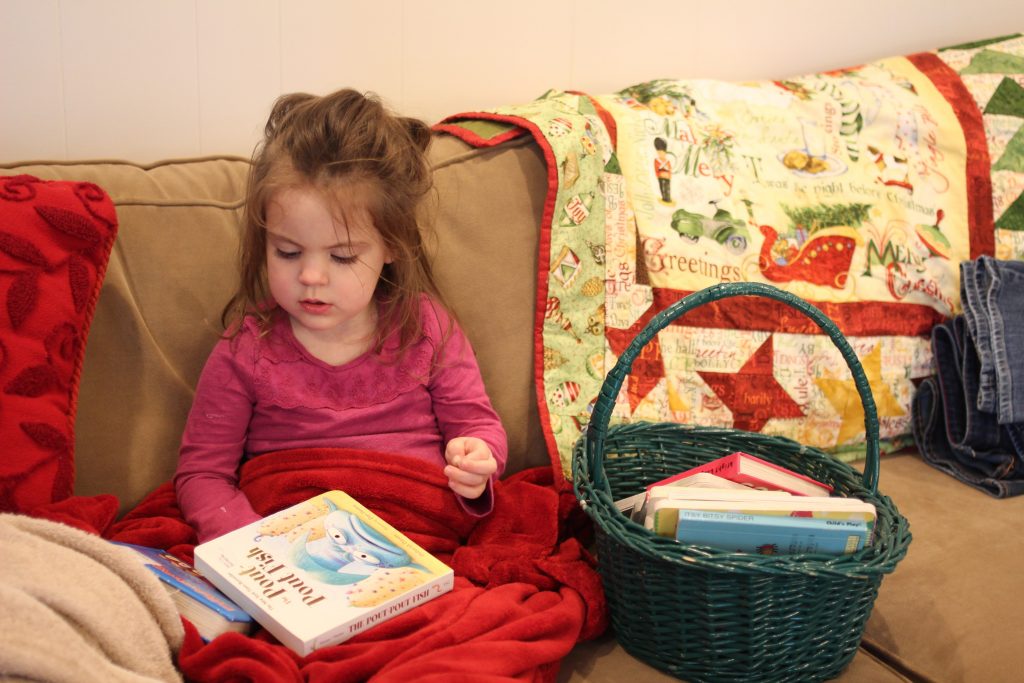
4. Not Making a Big Deal; The Power of Distraction
Of course, telling your toddler she can stop crying doesn’t work 100% of the time. Sometimes, the child just wants to carry on and on.
In that case, we calmly carry or walk our toddler to a different room if they need/ want to throw a huge fit over something and go get them as soon as they’re done.
You can have a whining/ tantrum “spot” on the floor in a room with the door closed – use some painter’s tape to mark it. Or you can use any old room with a door.
But the idea is to stay calm and tell your child, “That’s fine if you want to cry about this. You’ll just have to do it over here in _______.” Then go about your business elsewhere.
I actually just read this really great article on dealing with whining. It also goes hand in hand with this idea.
Distract Distract Distract!
The other part of not making a big deal is keeping all the conversations with your toddler as short and simple as possible.
The above 3 phrases are meant to be used in a short & sweet way. Don’t prolong the conversation. Toddlers are irrational and often confused. Keep your tone matter of fact, follow through on what you say. Avoid the temptation to yell or make empty threats.
As soon as you say it, move on.
Examples:
“Go bring your shoes to me so we can get ready to go. Say ‘okay, Mommy!'” (Child echoes, “Okay, Mommy.” We train this response around age 1… read my 1 year old discipline post to learn about that process if you haven’t done that yet. You can totally train it at age 2! It’s not too late!)
“Yep, you don’t get everything you want. Neither do I. Bummer. Come on, let’s go play _______.”
5. Time Out that Works!
First of all, time out is generally effective if implemented appropriately, but it doesn’t work for all children. It’s helpful to know what motivates your child.
If they could care less about being “left out” of what’s going on, time out might not really work as a discipline method. I have a child like this. She loves being alone. Time out is like a gift to her. Haha!
That being said, children that need alone time to recharge thrive on having some dedicated alone time. We enforce regularly alone/ quiet time with all our kids of all ages every afternoon. Sometimes, we do a 15-20 minute reset in the mornings too. If everyone is falling apart mid-morning, I will cheerfully announce, “It’s time for some alone time! Everyone head to their rooms with a book or toy. I will set the timer and let you know when you can come out.”
There might be some protesting when you first implement alone time, but eventually, they’ll get used to it and grow to like it!
Time out as a consequence and enforced alone time might look similar but they have two different purposes (even if there is a little overlap).
How to Do Time Out:
Time out is meant to communicate – you have not obeyed xyz, so now you do not get to participate.
A huge key to successful time out is for the parent to not be emotional. Remember, the child is the one who should experience the burden here. He is the one who did something wrong. Here’s how we do time out:
- State the problem with your “alpha speech” voice – Tommy, you may not shove someone who is in your seat to get your way. Time out.
- Calmly but firmly escort or carry the child to the time out spot. It should be quite removed. A different room, a particular chair, etc. It doesn’t have to be the same spot all the time.
- Walk away calmly. Require them to stay. If the child tries to come out, take him back.
- After 2 minutes (ish), go back and reexplain firmly – Do not shove someone to get your way. Do you understand? (Require a response. Yes, Mommy.) Okay, let’s go back and finish our snack.
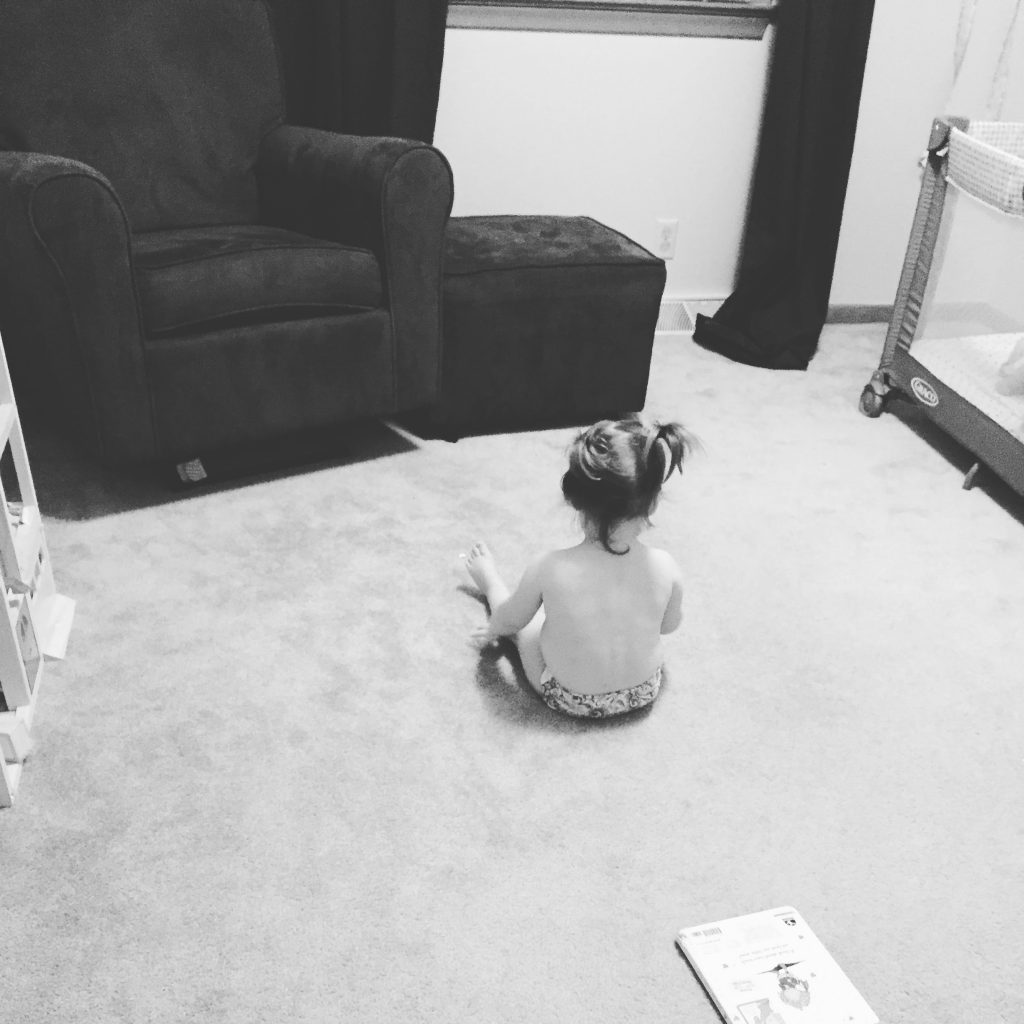
Alternatives to Time Out
Time out is especially effective and appropriate when the child will be missing out on something or having to wait longer.
It’s not super effective when, say, you are trying to get out the door and the child is not cooperating with socks/ shoes.
In that case, I’d take away the socks and shoes & plop the child in their carseat barefoot. I’d bring the other socks & shoes with me in the front seat, and after the child is buckled (screaming or not), I’d say, “When you stop screaming, I’ll talk to you about your socks and shoes. (Pause and wait for them to be able to hear you. If they don’t stop, walk away.) If/ when they do stop, say something to the effect of, “When you don’t listen and obey to get ready, you don’t get to pick your socks and shoes. Mommy’s in charge. You need to put your socks and shoes on when I say so. I’ll put them on for you when we get there.” And walk away.
Often, the key is to be as short, sweet, and simple as possible and end the conversation quickly without any questions!
My other most effective alternative to time out is the immediate loss of a privilege/ object – for a 2 year old, they will understand if you take away the toy they just threw. Or if you were about to have a snack of apples, and they throw a fit because they wanted candy, just don’t do a snack. They might scream and cry. That’s fine. Remove them from the situation and say, “No snack when you throw a fit. We’ll have a snack another time.”
The loss of privilege/ object has to be immediate. Two year olds won’t understand if you take away an activity or privilege at a later time. By age 4, the loss of a future privilege is effective.
FAQs
What if My Toddler is Strong-Willed?
To be clear, a screaming 2 year old does not mean your child is strong-willed. Screaming is normal for 2! And even a toddler that throws a fit about the same thing every day for quite a while isn’t necessarily strong-willed. Again, if the child is 2, that’s pretty typical.
BUT… maybe your child’s tantrums last ridiculously long. Maybe they persist in the same defiant behavior over and over – DARING you to do something about it. There’s something about the spirit of a strong-willed child that shows itself strong!! Our 3rd is particularly strong-willed, and as he turned 3.5 and 4, we began to see some of the benefits of consistent, firm, loving discipline & boundaries we had put in place at 2! (But it was a long, tiring 12-18 months of discipline before we really started to see a change.)
We’ve also used some different strategies with him than with our other toddlers who weren’t quite as opinionated. 🙂
Namely – we were more careful to choose battles, let certain things go, and think through what we really want to put our foot down on. Because I knew that if I said, “Don’t do that,” he’d probably fight it and I’d have to “win” the obedience training moment. So if it wasn’t something I wanted to discipline and win on, I let it go.
Separate articles could be written about the strong willed child, so for now, I’ll recommend a couple resources I’d recommend if you think your child is particularly stronger-willed than the average 2 year old:
- The New Strong Willed Child (Dobson)
- This article is full of fabulous advice and practical steps/ tips for parenting strong willed children. We did many things similar to what she recommends with our more strong-willed child.
Honestly, a strong will is a gift!! The strong willed child is less likely to get bullied or pushed around. They’re usually smart and determined and tender-hearted too! I mean, it’s not like we hope our children turn out ‘weak-willed.’
Screen Related Toddler Behavior Issues
Our opinion on this is relatively uncommon, but we have decided not to let our young children have ANY time on any sort of touch screens. No tablet time, no games on my phone in a waiting room or grocery cart. Nada.
With our first two toddlers, we did do the occasional game on mommy’s phone.
Eventually, we realized it seemed to breed whining, bad attitudes, entitlement, and a host of other undesirable behaviors. So we quit.
Cold turkey. We just said, “we’re not doing phone games anymore.” (We didn’t have a tablet.)
I just deleted all the games off my phone and made an effort not to be on my phone around the kids very much. We also told the grandparents and babysitters our preference for that, and they were kind to honor it.
Honestly, the shift in our kids’ behavior was drastic, and we never looked back! The more I dug into the newly forming research on how touch screens affect small children, the more I became 100% convinced it’s the right thing.
Did you know many higher-ups that work at tech companies don’t let their kids have access to smart phones or tablets either. Steve Jobs famously didn’t allow his kids to use an iPad!
I suppose this could be a whole separate article as well, but I wanted to mention that I firmly believe you will see long-term behavior changes if you go through the temporarily painful process of having your toddler quit touch screens cold turkey.
What About Food Battles?!
Ummmm yeah. We don’t really fight our kids on food. We serve what we serve, we try to eat more healthy food than junk food, and we don’t have big battles about it. Here’s our entire approach to getting kids to eat vegetables & minimize drama related to eating (complete with TONS of healthy recipes the kids love)!
Any More FAQS?
Ask questions in the comments and I’ll add them here over time!
Do you have any go-to phrases or tips that help your terrific two year olds with all their toddler behaviors and feelings!? 🙂
I’ll be curious to hear if anyone tries using these phrases & strategies with their kiddos and gets the same positive results we’ve had.
By “positive results,” I don’t mean perfectly behaved two year old. I do mean seemingly increased understanding (at least at a 2 year old level) about authority, respect, life, managing emotions, ya know… things of that nature.
Perfect behavior isn’t the goal anyway.
The idea is gospel-centered parenting… that over time, your child would realize she can’t be perfect (even if she tries really hard) and she needs Jesus! And so does Mom. (This book explains gospel-centered parenting really well.)
May the force & strong coffee be with you.
p.s. I’m working on putting together a short, self-paced toddler parenting course. It’ll be comprised of short, downloadable audio-files that you can listen to at your own pace. It’s full of practical tips you can use with your toddlers in every day life. Sign up below if you want access to the launch discount codes.
Related Posts:
31 ways to entertain toddler while you feed the baby – (Some of these are simple learning activities for new language skills at an appropriate child development age too!)
12 Practical Tips for Surviving Life with a Toddler & Newborn (If you’re thinking about getting pregnant to have a toddler & a baby, this will help!!)
Ultimate Guide to 2 Year Old Sleep Schedule & Problems (including potty training related sleep issues!)
41 Easy & Fun Fall Activities for Toddlers & Preschoolers
33 More Free & Easy Activities for Toddlers
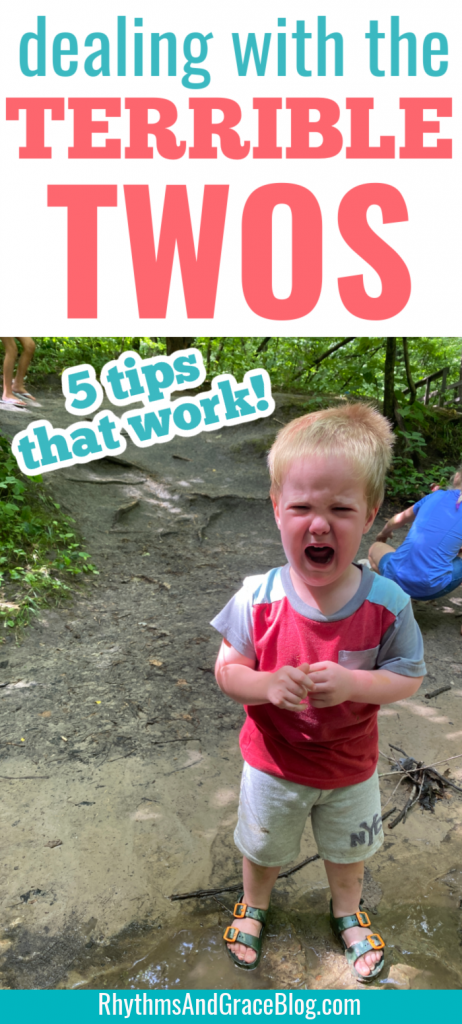


yes!! natural consequences are the best tool when available!
The natrual consequences work so well, it’s what i use to discipline my 2 children and it is the best way to get them to do what i want!! thanks x
I love that!! I say, “I understand” a lot in the same way. Great idea to add that to this post!! Thank you for sharing 🙂
I have a friend and her go to, which I love and will
Be using for my nearly toddler, is “I hear you……”. For instance, “I hear you don’t want to go to bed right now but we have to get up early for daycare so now is the time to choose to obey mommy.” Or “I hear you want more of that…”. She said it makes her son feel heard, acknowledges his feelings, and doesn’t steam roll him with a becaus ei said so, but still comes back around to mom is the authority.
lol. gotta love those natural consequences… 🙂
I love all three of these. My go-to anymore is “be safe” as my 2 year old climbs anything and everything, and tries to multi-task while walking up the stairs. Most of the time just asking “are you being safe?” is enough to jog his memory that climbing a stack of 10 pillows leads to no-so-fun consequences!
Danielle – thanks for stopping by. So glad you found these helpful 🙂 Of course you can share! Thank you!! I have a post about one year olds too – did you see that one!? it’s CRAZY how much our little one year olds can understand. hopping over to check out your blog now!
I love these! THey’re not the quick phrases you hear parents say all the time like ” because I said so” but they’re so wise! THanks for sharing these! My baby boy is 1 year old just now and I anticipate having to use some of these soon! By the way, I want to share this in my weekly series called “Roll Out The Red Carpet Thursday” – I share bloggers’ amazing posts that I’ve found during the week. I hope that’ ok! Have a great day!
Hahaha!!! That’s what grandma’s are for. And That’s why when we’re at Grandma Cathy’s house, Addie tells me, “No mom, not you. Just Addie and Grandma Caffy.” 🙂
My go to phrase for the above mentioned child is, has been, and shall be: “Whatever you want, sweetie pie!!”